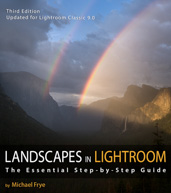Light and Weather
by Michael Frye | Jun 29, 2025 | Light and Weather
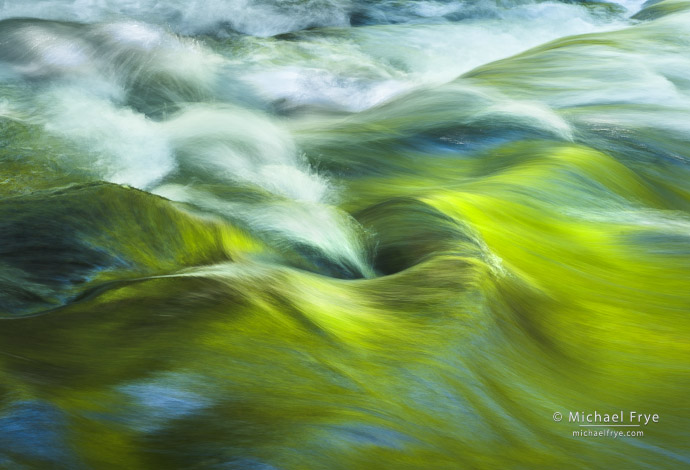
Cascade and spring reflections, Great Smoky Mountains NP, Tennessee. I loved the repeating patterns created by the standing waves in this cascade, coupled with the vivid green reflections. 52mm, 1/3 sec. at f/16, ISO 100.
You can find every shade of green in the Smokies in spring – light green, dark green, blue-green, yellow-green, and everything in between. Occasionally the greens are mixed with a splash of blue sky or white water, but it’s a green world.
Our eyes and brains can distinguish more shades of green than any other color. The cones in our retinas, which perceive color, are more sensitive to green wavelengths than other colors – not surprising for a species that evolved in African forests, where distinguishing between shades of green helped find food and avoid predators.
(more…)
by Michael Frye | Jun 15, 2025 | Light and Weather, Vision and Creativity
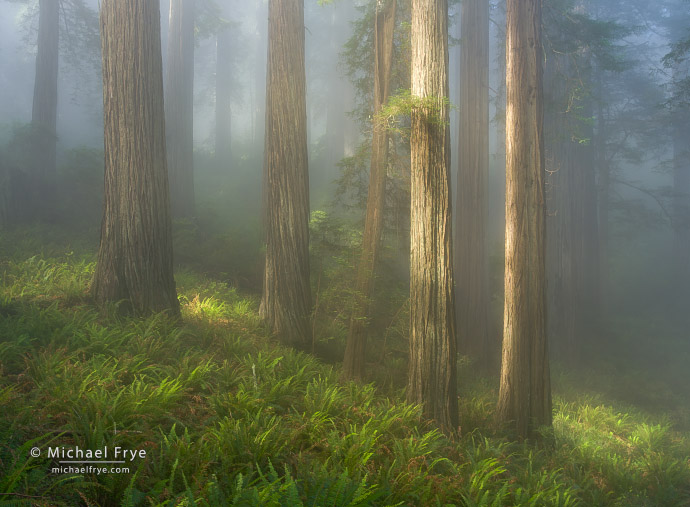
Sunlight, fog, and redwoods, Northern California
Claudia and I recently returned from two weeks in the far northwest corner of California among the redwoods. And we loved it there, as always. It’s one of my favorite places on the planet.
I love forests in general, including the hardwood forests in the eastern U.S., the conifer forests of Yosemite, aspens in the western mountains, and the moss-draped, old-growth forests of the Olympic Peninsula. They’re all great.
But the redwoods are extra-special to me. Among these giant trees, I feel like I’ve been transported back in time. It’s easy to imagine dinosaurs roaming forests like these – because they did. During the Cretaceous period, the height of the dinosaur’s reign, some 145 to 66 million years ago, ancestors of redwoods were abundant, covering large tracts of the northern and southern hemispheres. If redwood forests seem ancient and primeval to me, it’s because they really are ancient. That earthy smell of redwoods and ferns I notice when I enter a redwood forest was probably familiar to many dinosaurs.
(more…)
by Michael Frye | May 4, 2025 | Composition, Light and Weather, Travels and Stories

Sunbeams and ridges, Great Smoky Mountains NP, North Carolina
Claudia and I just returned from Tennessee and the Out of the Great Smoky Mountains photo conference. Technically this wasn’t our first visit to Great Smoky Mountains National Park, since eleven years ago we landed briefly in Cherokee, on the North Carolina side of the park, after driving to the southwest terminus of the Blue Ridge Parkway. But for all practical purposes this was our first time exploring the park, and definitely the first time visiting the Tennessee side.
And we loved it. Well, most of it. Gatlinburg is… something. And the traffic in Cades Cove can be crazy. But the park itself is beautiful. I love the hardwood forests of the Smokies, which are so similar to the woods I played in as a child growing up in the Northeast. These forests were especially pretty decked out in their bright spring greens, with rushing creeks and rivers cascading under the arcing branches of the trees.
(more…)
by Michael Frye | Apr 10, 2025 | Composition, Light and Weather
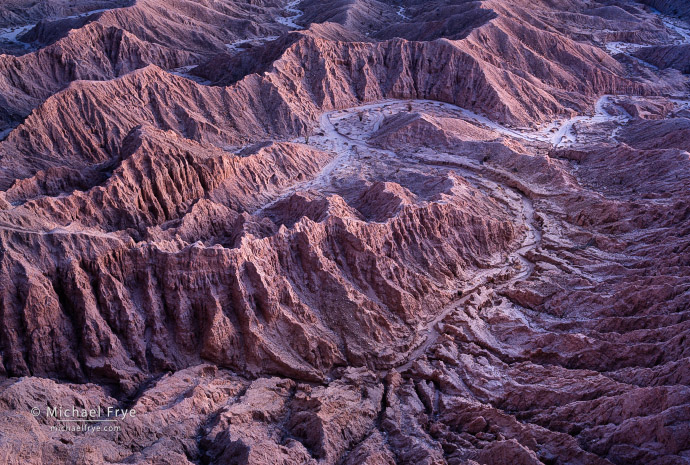
Twisting wash, badlands, Southern California. The curvy lines of the wash and surrounding ridges created a design I could build a composition around. Soft sidelight from the post-sunset glow brought out the forms and textures of the land, without the harshness of direct sunlight.
In late March Claudia and I joined photographer friends in the deserts of Southern California. We enjoyed just hanging out together, but I also got to visit some badlands areas I’d never photographed before, which was lots of fun.
To me, photographing badlands is similar to photographing sand dunes. Both have acres of naked earth, sculpted into interesting shapes and forms by either wind or water. With badlands the shapes are more angular than in dunes, but you can find great designs in both environments.
(more…)
by Michael Frye | Dec 29, 2024 | Light and Weather
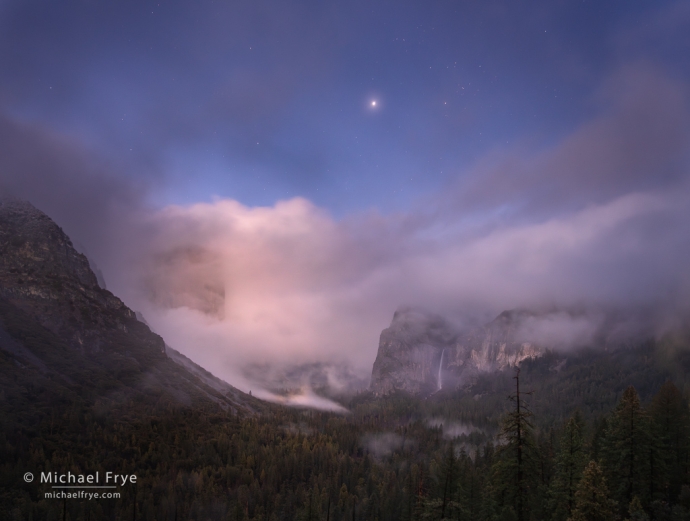
Yosemite Valley at dusk with stars and Jupiter, Yosemite NP, California. This storm cleared just after sunset. It was dark enough for stars to appear, but with a post-sunset glow still lingering on El Capitan. 25mm, 10 seconds at f/4, ISO 2000.
We’ve stayed close to home this month, but I’ve been making lots of photographs. I previously posted photos of fog in the foothills, and ice in Yosemite. But I’ve also been able to photograph Yosemite with clearing storms, and mist, and a moonrise, and with just ordinary, beautiful winter light.
Yosemite Valley is small – only seven square miles. This tiny area is renowned for its grand scenery, but it also contains a wonderful variety of beautiful details and intimate landscapes. No matter how many times I go back, I always find new things to photograph – or find that the same spots look new, and different, under different conditions. There’s always something to photograph there, if I look.
(more…)
by Michael Frye | Dec 22, 2024 | Light and Weather
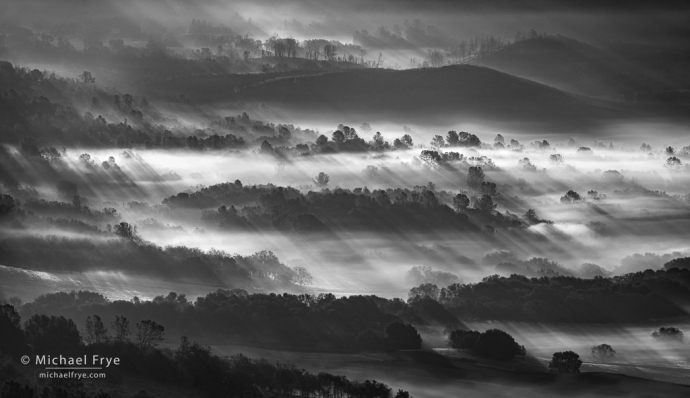
Fog and sunbeams, Sierra Nevada foothills, California. I made this image Wednesday morning, after the sun rose high enough to rake across these layers of fog and trees. In color it was all one note, with everything a pale gold color. Since it was monochromatic anyway, I tried it in black and white, and liked that much better. I think the color distracted from the main story of the photograph, which is about the layers, patterns of light and dark, and tree shadows. 321mm, 1/200 sec. at f/11, ISO 100.
California’s Central Valley is often filled with fog in winter. Usually a shallow layer of fog forms during the night, then burns off the next morning as the sun warms the air. There’s a temporary, low-level inversion during the night and early morning, where the air near the ground is cooler than the air higher up, but when the sun penetrates the fog and warms the ground the inversion ends.
Sometimes, however, the fog in the Central Valley is so thick it doesn’t burn off. The weak sunlight on short winter days never penetrates the fog layer completely, so the fog lasts all day, and into the next night. If the fog persists for a couple of days the inversion will grow deeper (it can get up to two- or three-thousand feet deep), and the fog will gradually lift off the ground into a low overcast, or stratus deck. And then that higher-altitude fog layer will push up into the Sierra foothills. A stratus deck like this can last for several days, or even a week, until a disturbance in the atmosphere (like a storm, or even a weak, dry front) mixes the air and ends the inversion.
(more…)













